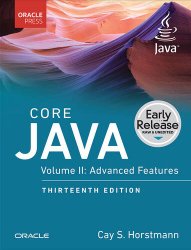Core Java, Volume II: Advanced Features, 13th Edition (Early Release)
- Добавил: literator
- Дата: 9-05-2024, 03:30
- Комментариев: 0
 Название: Core Java, Volume II: Advanced Features, 13th Edition (Early Release)
Название: Core Java, Volume II: Advanced Features, 13th Edition (Early Release)Автор: Cay S. Horstmann
Издательство: Oracle Press/Pearson Education
Год: 2024
Страниц: 944
Язык: английский
Формат: epub
Размер: 19.2 MB
The Classic Guide to Advanced Java Programming: Fully Updated for Java 21.
Core Java is the leading no-nonsense tutorial and reference for experienced programmers who want to write robust Java code for real-world applications. Now, Core Java, Volume II: Advanced Features, Thirteenth Edition, has been revised to cover the new features and enhancements in the Java 21 long-term support release. As always, all chapters have been completely updated, outdated material has been removed, and the new APIs are covered in detail.
This volume focuses on the advanced topics that a programmer needs to know for professional software development and includes authoritative coverage of enterprise programming, networking, databases, security, modularization, internationalization, code processing, and native methods, as well as complete chapters on the Streams, XML, and Date and Time APIs. In addition, the chapters on Swing and Graphics cover techniques that are applicable to both client-side user interfaces and server-side generation of graphics and images.
Cay S. Horstmann clearly explains sophisticated new features with depth and completeness and demonstrates how to use them to build professional-quality applications. Horstmann's thoroughly tested sample code reflects modern Java style and best practices. The examples are carefully crafted for easy understanding and maximum practical value, so you can rely on them to jump-start your own programs.
In Chapter 1, you will learn all about the Java stream library that brings a modern flavor to processing data, by specifying what you want without describing in detail how the result should be obtained. This allows the stream library to focus on an optimal evaluation strategy, which is particularly advantageous for executing computations in parallel with multiple cores.
The topic of Chapter 2 is input and output handling (I/O). In Java, all input and output is handled through input/output streams. These streams (not to be confused with those in Chapter 1) let you deal, in a uniform manner, with communications among various sources of data, such as files, network connections, or memory blocks. We include detailed coverage of the reader and writer classes that make it easy to deal with Unicode. We show you what goes on under the hood when you use the object serialization mechanism, which makes saving and loading objects easy and convenient. We then move on to regular expressions and working with files and paths. Throughout this chapter, you will find welcome enhancements in recent Java versions.
Master advanced techniques, idioms, and best practices for writing reliable Java code
Make the most of enhanced Java I/O APIs, object serialization, and regular expressions
Connect to network services, harvest web data with the HTTP/2 client, and serve data with the built-in web server or implement your own server
Process code via the Scripting and Compiler APIs
Deepen your understanding of the Java Platform Module System, including recent refinements
Leverage the Java security model, user authentication, and the security librarys cryptographic functions
Preview powerful new APIs for accessing "foreign" functions and memory
"This is the definitive reference and instructional work for Java and the Java ecosystem."
--Andrew Binstock, Java Magazine
See Core Java, Volume I: Fundamentals, Thirteenth Edition, for expert coverage of Java programming fundamentals, including objects, generics, collections, lambda expressions, concurrency, and functional programming.
Скачать Core Java, Volume II: Advanced Features, 13th Edition (Early Release)
Внимание
Уважаемый посетитель, Вы зашли на сайт как незарегистрированный пользователь.
Мы рекомендуем Вам зарегистрироваться либо войти на сайт под своим именем.
Уважаемый посетитель, Вы зашли на сайт как незарегистрированный пользователь.
Мы рекомендуем Вам зарегистрироваться либо войти на сайт под своим именем.
Информация
Посетители, находящиеся в группе Гости, не могут оставлять комментарии к данной публикации.
Посетители, находящиеся в группе Гости, не могут оставлять комментарии к данной публикации.
